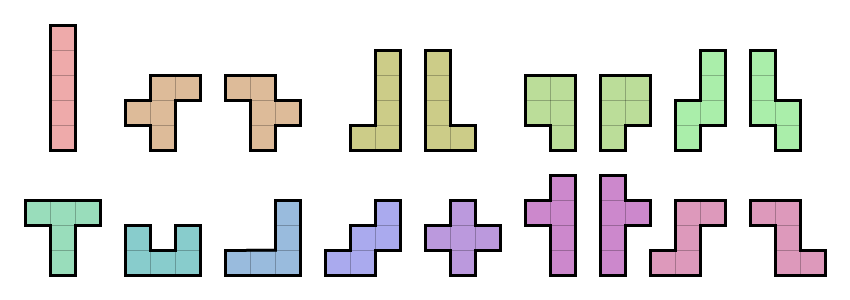
________________
The Varsity Math team decides to celebrate the midpoint of summer (halfway between the summer solstice and the fall equinox) by holding a Geometry Day. Here are a couple of puzzles from that day.
________________

Deck a Tile
Jules is playing with a pentomino set and suddenly shouts out in excitement. (A pentomino is any shape made from five identical squares by joining them along the full lengths of their edges.) “I have discovered a truly remarkable shape! Ten copies of the shape can be arranged (with some of them possibly flipped over) to form a rectangle, but with any fewer than ten copies, it’s impossible to make a rectangle.”
What is Jules’ shape?
Try a Section
Points A and B are on the perimeter of circle O with center C. Radius CD is parallel to AB, with D on the same side of line AC as B. Point E lies on ray CD outside of O, and AE intersects circle O at T. Finally, the length ET is the same as AC.
What is the ratio of the measure of angle TAB to that of angle CAB?
| Spread the word: | Tweet |
Solutions to week 45
Boat Row. A roundtrip (two crossings) can only ferry one person across, since someone must row back. So without any constraints, it would take at least four roundtrips plus a single crossing with two people to get everyone across, for nine crossings. However, the first and second rundtrips must both deposit players on the far side, because otherwise some player would end up being with a different agent (and not the player’s own agent). That means the first time that there are four people on the far side, there can be at most two agents, which will require that two people row back to avoid a player being with a different agent and not the player’s own. Thus, one of the roundtrips does not increase the number of people on the far bank, meaning that it will take at least eleven crossings. The solution is of course not complete without demonstrating an eleven-crossing solution, as follows. (Agents are upper case, players lower case.)
| Left bank | Boat | Right bank |
|---|---|---|
| ABCabc | ||
| Aa > | ||
| BCbc | Aa | |
| < A | ||
| ABCbc | a | |
| bc > | ||
| ABC | abc | |
| < c | ||
| ABCc | ab | |
| AB > | ||
| Cc | ABab | |
| < Bb | ||
| BCbc | Aa | |
| BC > | ||
| bc | ABCa | |
| < a | ||
| abc | ABC | |
| ab > | ||
| c | ABCab | |
| < b | ||
| bc | ABCa | |
| bc > | ||
| ABCabc |
Meandering Mate. The queen in this problem has to tour every space on the chessboard (counting her starting square and the King’s square). What’s the minimum number of moves that could possibly take? First, imagine she were only a rook. Then her first move could either be along a row or a column; since we could just rotate the board, it’s safe to assume that it’s along a row. That move can at most visit every square along that row, so there are at least seven rows remaining with at least eight squares each remaining. Now, the piece is on the row that was just eliminated, so the next move cannot eliminate more than one square on any other row (since the rook must move along a column in order to change rows). So after two moves, there are at least seven rows with at least seven squares each to visit. The third move could again be along a row, and could visit every square on that row, so there must be at least six rows remaining with at least seven squares in each row left to visit. The rook has to change rows on the next move, which can visit at most one square on each row, so after four moves there are at least six rows remaining with at least six squares in each row left to visit. Continuing in this way (after six moves there are at least five rows remaining with at least five squares in each row left to visit, etc.) we see that after 14 moves there is still at least one row remaining with at least one square left to visit, so a rook must take a minimum of 15 moves to visit every square on the board.
However, exactly the same argument applies to the Queen herself: a move along a row can at most eliminate one entire row, and all the other moves available, once an entire row has been visited but the Queen is on that row, can visit at most one square from any other row. That is to say, just like the column moves of a rook, the diagonal moves of the Queen also intersect each row in at most one square. Hence, the Queen must also take at least 15 moves to complete the journey called for in this problem.
 Finally, it is in fact possible in just 15 moves, as shown in this diagram.
Finally, it is in fact possible in just 15 moves, as shown in this diagram.
Recent Weeks
Week 45: Boat Row & Meandering Mate, solutions to Guarding Variety, and As the Day is Wrong
Week 43: Relation Riddle & Crusty Conundrum, solution to The Old Coin Game
Week 42: Triangulating the Difference & The Old Coin Game, solution to A Day Late and A Fence Short
Links to all of the puzzles and solutions are on the Complete Varsity Math page.
Come back next week for answers and more puzzles.
[asciimathsf]














